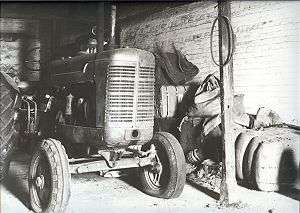Coombing Park
Coombing Park is a farming property situated in western New South Wales just off the Mid-Western Highway about 5 km west of Carcoar,[1] 260 km west of Sydney and 54 km south-west of Bathurst. The property is of considerable note because of its relationship with convicts, bushrangers and the Cobb & Co coaching company. The property was offered as an estate to its owner Thomas Icely by the early New South Wales Government in 1826. It was one of the first estates created on the western side of the Blue Mountains that border the area of Sydney.
History
Thomas Icely enlisted (not of their own free-will) the help of 62 convicts to build the original homestead and outbuildings between 1838 and 1842 and indeed the original shearing shed and stables are still standing from their construction date of 1848.

The eastern boundary of the property borders the Mt Macquarie road which leads directly to the town Carcoar, which was specifically created in 1839 so as to service the Coombing Park estate and is situated about 1 kilometre away. The town required the presence of about 27 Mounted and Foot Police, specifically with the aim of controlling the frequent appearance of bushrangers in the area. One notorious bushranger directly related with the Coombing Park property was Mickey Bourke who shot and wounded an employee of Coombing Park whilst he was stealing a racehorse from the stables.
Thomas Icely's original cottage was replaced by a large single storey but elegant brick villa that was designed and built by G.A. Mansfield in 1900. This was some 20 years after the property had been purchased in 1881 by the Cobb & Co coaching company and occupied by a partner of the Cobb & Co firm, a Mr William Franklin Whitney. Whitney's descendants still own and live on the property. It retains much Cobb & Co memorabilia.
There was a quarry on the property, which provided iron ore from around 1899, for use as flux at the Cockle Creek Smelter. Later and more significantly, it provided ore for the Lithgow Blast Furnace, from late April 1907 up to May 1923, when the lease expired and was not renewed. This second ore mining operation included a rail line, 1¼ miles in length, connecting the quarry to the Blayney–Demondrille railway line near Carcoar.[2][3][4][5]
Holistic management
The property is still a working farm. Once on the verge of ruin, with severe land degradation, the farm was turned around using Allan Savory's holistic management farming techniques, where the livestock are grouped together and herded to mimic the migrations in nature of herds of wild herbivores.[6][7]
References
- "Carcoar". Sydney Morning Herald. 2004-02-08. Retrieved 2008-09-04.
- "COUNTRY NEWS". Sydney Morning Herald (NSW : 1842 - 1954). 1899-12-14. p. 8. Retrieved 2020-06-01.
- "NEW IRONWORKS AT LITHGOW". Sunday Times (Sydney, NSW : 1895 - 1930). 1907-05-19. p. 12. Retrieved 2020-06-01.
- "RICH IRON MINES - Hoskings to Leave CARCOAR, Thursday. - Evening News (Sydney, NSW : 1869 - 1931) - 15 Nov 1923". Trove. Retrieved 2020-06-01.
- "Carcoar Iron Mines - ALL MACHINERY REMOVED PROSPECTS FAR FROM BRIGHT CARCOAR, Friday. - National Advocate (Bathurst, NSW : 1889 - 1954) - 19 Jan 1924". Trove. Retrieved 2020-06-01.
- "Interview with Allan Savory". Landline. Australian Broadcasting Corporation. 24 July 2011. Retrieved 28 December 2018.
- "Video: Interview with Allan Savory". Landline. Australian Broadcasting Corporation. 23 July 2011. Retrieved 12 March 2013.